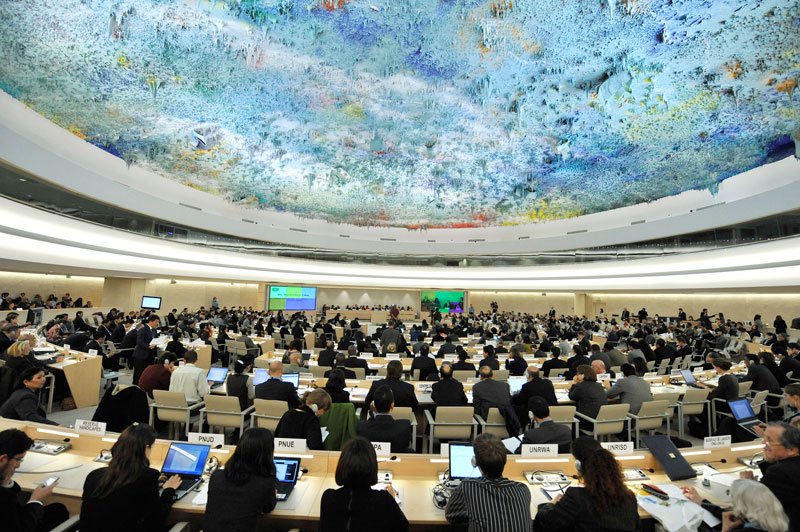The Trump administration has a decision to make on the Human Rights Council: will it stay or will it go?
The Human Rights Council is a 47 member body that meets several times a year to discuss human rights issues around the world; evaluate countries’ commitments to human rights; hear from special rapporteurs they dispatch to investigate alleged abuses; or otherwise set norms around human rights issues worldwide, like protections of the LGBT community worldwide.
From the perspective of American politics, there have been two basic approaches to the Council since it was created in 2005.
The first considers the Human Rights Council is fatally flawed. That is, its makeup, and rules of procedure preclude any possibility of it being a force for good that can advance American interests and human rights. Joining the Human Rights Council confers legitimacy to the body, whereas US policy should be to delegitimize the whole enterprise. This was largely the policy of the George W. Bush administration, which never sought election to the 47 member council.
The alternate strategy accepts that the membership guidelines and rules of procedure can sometimes lead to outcomes that are suboptimal, but that by working within the council the USA can both maximize the potential of the council while limiting the harm. That is, by joining the council the USA has greater leverage to rally the world around its priorities while blocking bad actors from joining the body and mitigating what the USA considers harmful actions against allies like Israel. This was the approach taken by the Obama administration, which was elected to the council just weeks into President Obama’s first term. Under this approach, the Human Rights Council took the historic decision to mainstream LGBT rights into the global human rights architecture; blocked Iran and Syria from joining the council; and dispatched several special rapporteurs to investigate and document rights abuses in places like Eritrea, North Korea, Syria and elsewhere. In her Cabinet Exit memo, Samantha Power sums up the Obama administration’s approach:
We believe that we are more effective in championing open societies, political and civil freedoms, and norms of moderation and tolerance by harnessing the UN system to defend human rights, and we have amassed a significant track record of using the Council to advance our values and interests.
Through our active leadership, we have helped to authorize international commissions or rapporteurs empowered to investigate, expose, and address the human rights situation in some of the world’s most abusive countries, including Iran, Syria, North Korea, Sudan, and Russian-occupied Crimea. We thwarted efforts by Iran in 2010 and Syria in 2011 to join the UN Human Rights Council; and we spearheaded the unprecedented decision to suspend Qaddhafi’s Libya from the UN Human Rights Council in 2011. In response to Sri Lankan President Mahinda Rajapaksa’s atrocities against Tamil civilians, the United States led the UN Human Rights Council beginning in 2012 to adopt resolutions insisting on accountability for Rajapaksa’s abuses. This diplomatic isolation reportedly influenced some Sri Lankan voters, who in 2015 voted Rajapaksa out of office and elected Maithripala Sirisena, who has worked to enact a far reaching reform program. Although it is highly problematic that the UN Human Rights Council still includes only one permanent agenda item – not on North Korea or Syria, but rather on Israel – through our leadership in the Council since 2009 we have succeeded in getting the body to expand its focus, reducing by half the share of country-specific resolutions on Israel.
The Trump administration has a decision to make: will it seek to work within the system to steer decisions and influence outcomes? Or will it boycott the whole enterprise? A recent letter from Secretary of State Tillerson to human rights advocacy groups that want the Trump administration to continue to engage the council suggests that the decision is very much still up in the air. “We continue to evaluate the effectiveness of the UN Human Rights Council,” Tillerson wrote.“While it may be the only such organization devoted to human rights, the Human Rights Council requires considerable reform in order for us to continue to participate.”
The USA is currently in its second year of a three year term, which expires in 2019. The State Department has said the USA will engage with the current session of the council, which lasts through the end of March. Going forward, the Trump administration has three basic courses of action. It could withdraw its membership from the Council before the term ends–essentially giving up the seat to which it was elected. It could opt not to run for re-election in 2019. Or it could seek another three year term which would expire in 2022.
The next inflection point comes in June, when the the Human Rights Council convenes for its next regularly scheduled session. Whether or not the USA takes its seat at the table — and uses that position of influence to steer the council’s decisions in America’s favor — is apparently still up in the air.
